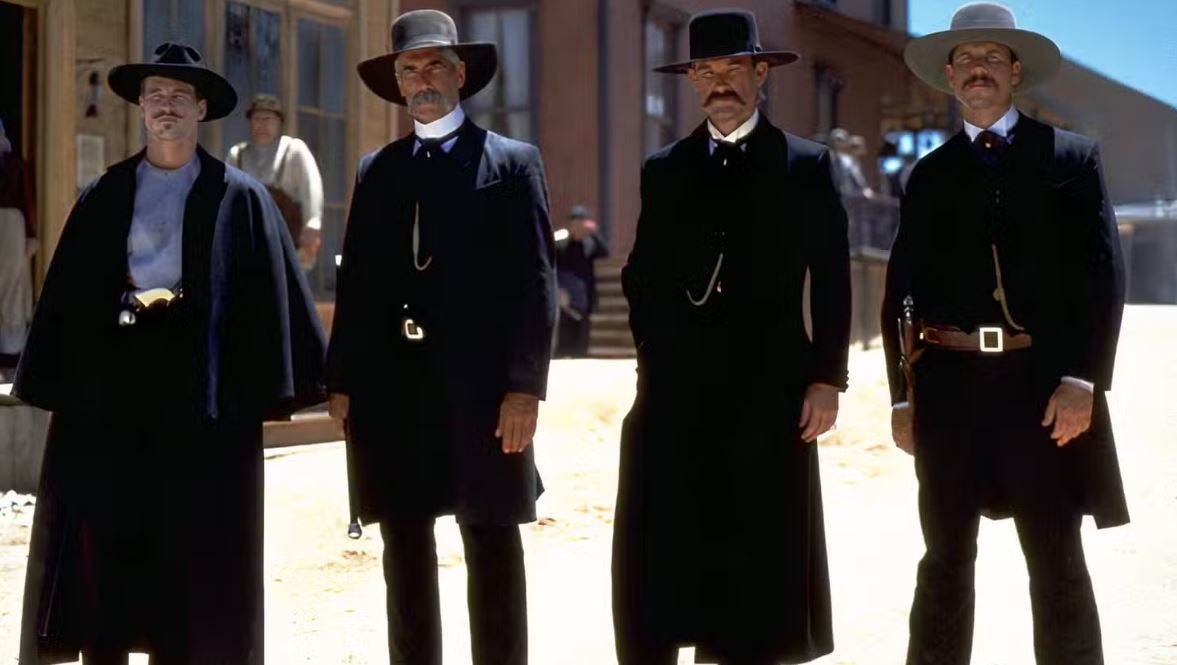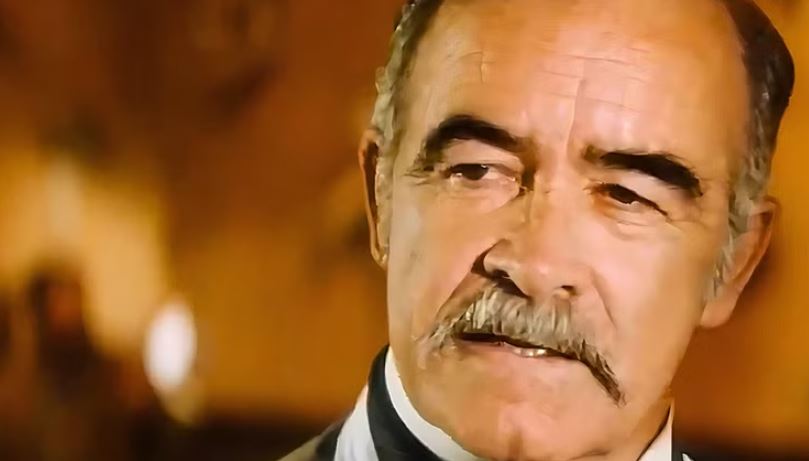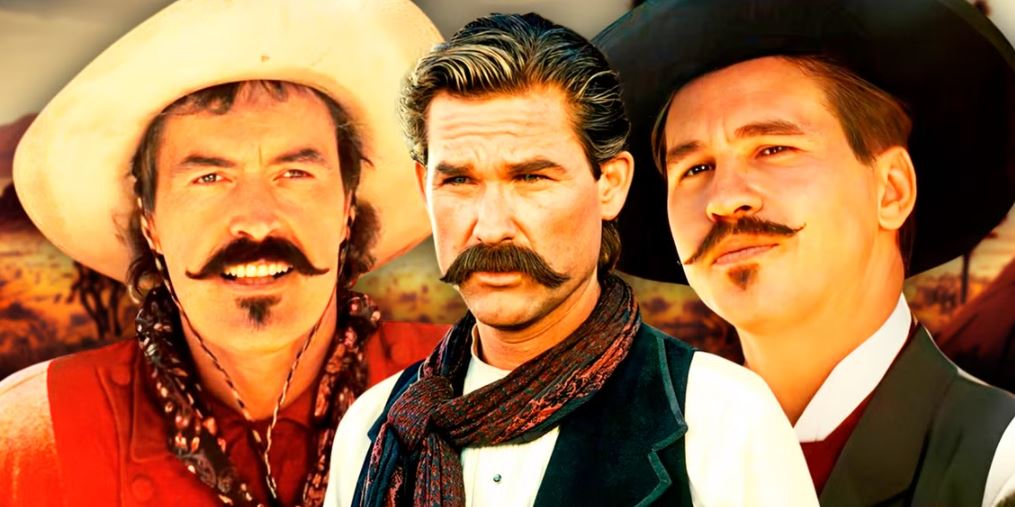The classic American Western film might have peaked in popularity with 1993’s Tombstone, thanks to its potent combination of Doc Holliday one-liners, pitch-perfect Old West action, and gloriously mustachioed cast. Each member of Tombstone’s star-studded cast was integral in bringing the story, which was a glamorized and somewhat exaggerated version of the real historical event known as the Gunfight at the O.K. Corral. At the time of its release, neither the box office nor the critical reception for Tombstone were noteworthy, but its popularity has grown significantly over time thanks to its lasting entertainment value.
As entertaining as the performances in Tombstone are, the actors’ commitment to bringing their real historical counterpart to life on the silver screen from a visual perspective is part of why the movie has become so beloved. While historical accuracy is often eschewed in favor of cinematic machismo and verbal sparring when it comes to the narrative, there was plenty of effort put in to keeping the costumes period-accurate for the Old West. Tombstone’s most iconic costume element isn’t the dusters, the Stetsons or the six-shooters, it’s undoubtedly the mustaches.
Tombstone’s Cast Grew Real Mustaches For The Movie
The Entire Cast Took The Time To Grow Period-Appropriate Facial Hair
Tombstone’s cast is absolutely loaded with well-known names and faces, but most of the most famous actors in the movie (both at the time and now, decades later) are hidden behind different styles of period-accurate mustaches. While stars Sam Elliott and Kurt Russell have often worn mustaches in movies and TV, it wasn’t quite as common a practice for other actors involved in the movie. Michael Biehn, Powers Boothe, Bill Paxton, and certainly Val Kilmer have had far more notable clean-shaven roles, and so their mustaches seem almost out of place.
However, each member of the cast, regardless of their history in movies or TV, took care to grow an actual mustache that would have been reflective of the time period, if not reflective of actual photographs that might have existed of their characters. In an interview with MovieWeb, Michael Biehn, who plays the villainous Johnny Ringo in Tombstone, noted that the initiative to have everyone in mustaches came from the movie’s original director (before he was fired), writer Kevin Jarre. Biehn noted:
He was very specific about how he wanted the moustaches. He wanted them to curl up on the end. Which means, if you grow a moustache, and it grows long enough, you have to use wax on the end of it. Everyone was pretty proud that they grew their own moustache.
It seems like a small detail, but in the larger context of the movie’s popularity, the mustaches have become maybe the single most important identifying feature. That’s not to say the movie wouldn’t have been as popular without the mustaches, but it certainly helped cement its legacy.

Why One Tombstone Actor Needed A Fake Mustache
Jon Tenney Didn’t Have The Time To Grow A Proper One
In the same interview, Biehn noted that in the entire movie, there is only one mustache that had to be faked: that of Sheriff Johnny Behan, portrayed in Tombstone by Jon Tenney (The Closer). To be clear, it had nothing to do with Tenney’s commitment, or lack thereof, to the role. Tenney simply didn’t have the time to grow a full one, having just finished shooting another role for which he was clean-shaven (likely the 1993 comedy Watch It). To fit in with the rest of the cast, Tenney was given a fake mustache that was put on and taken off for each day of shooting.
Tenney’s (Lack Of) Mustache Was One Of Many Production Challenges In Tombstone
Director Changes, Script Changes, And Casting Issues Plagued The Production
Jon Tenney’s lack of mustache was not really a problem in the grand scheme of things given its easy solution. Other problems required far more improvisation during production, most significantly surrounding the movie’s direction. Tombstone was originally supposed to be the directorial debut for writer Kevin Jarre, but with no prior experience, he was quickly overwhelmed by the rigorous shooting schedule, which fell behind. As a result, the movie’s producers fired Jarre, and replaced him with George P. Cosmatos (Rambo: First Blood Part II), who had experience with large-scale action and adventure films.
The transition from Jarre to Cosmatos was difficult, as the famously intense new director clashed with different members of the production crew. Michael Biehn, who plays Johnny Ringo in the movie, nearly quit due to his close personal friendship with Jarre. On top of that, Jarre had left a mess of a script behind.
Fortunately, Kurt Russell took the reins to get the production back on track. He and producer James Jacks worked on the script and trimmed it to make it much simpler, and specifically made the call to focus on Wyatt Earp and Doc Holliday. It’s widely believed (and has been confirmed by Russell) that it was actually Russell who truly directed the film, and that Cosmatos was brought in essentially as a “ghost director” to keep Russell’s high level of involvement out of the public eye. Val Kilmer has since confirmed Russell’s work on the film.
On top of the script and direction, filling out the sprawling cast proved to be a challenge at different times. American screen legend Robert Mitchum was originally cast in the movie as Old Man Clanton, but was injured falling off his horse during shooting and became the movie’s narrator instead. Veteran Western actor Glenn Ford was originally supposed to play Marshall White, but he fell ill during filming. Even Val Kilmer’s iconic role as Doc Holliday was a backup plan, as Willem Dafoe was the original choice, but the distribution company nixed the idea due to his controversial recent role in The Last Temptation of Christ.

Which Character Had The Best Mustache In Tombstone?
Kurt Russell’s Thick Upturn Is The Most Iconic
Each of the mustaches in Tombstone is worthy of acclaim, but some truly stand out on the big screen. Val Kilmer’s clean, tight mustache with a subtle waxed upturn is perfect for his character, as is Jason Priestley’s mustache-goatee combo. Sam Elliott is one of the most famous mustachioed leading men in Hollywood, and he’s certainly at the top of his game in Tombstone in that regard.
Kurt Russell’s thick mustache accentuates the gravitas and machismo of Wyatt Earp, and elevates some of Tombstone’s most iconic quotes.
However, the thick, curled mustache that Kurt Russell grew for Wyatt Earp is the best mustache in the movie, especially knowing that it’s a genuine mustache. The thickness is an essential part of the character that sets him apart from the rest of the cast, as it almost dominates his face. It accentuates the gravitas and machismo of Wyatt Earp, and elevates some of Tombstone’s most iconic quotes.
Tombstone Isn’t The Only Movie With A Famous Mustache Story
Henry Cavill Had A Mustache Removed In Justice League
One of the most infamous mustache stories from movies came in the DCU film Justice League. In that film, Henry Cavill reprised his role as Superman, but there was one big problem. There was no problem for the main shoot, as Cavill was clean-shaven for Zack Snyder. However, after Snyder left the film when his daughter died, Joss Whedon came in and re-shot much of the film. By this time, Henry Cavill was shooting Mission: Impossible – Fallout, which required a mustache he couldn’t shave off for the re-shoots.
Since Cavill was contractually obligated to keep the mustache for the new movie, and the re-shoots couldn’t force him to shave it, the post-production team had to go into every scene that Cavill shot and remove the mustache, which looked terrible in many scenes. “To have a fake mustache on would not have been a possibility,” Cavill told Empire magazine about not shaving for the Justice League reshoots.
Of course, not all fake mustaches are a bad thing. In A Haunting in Venice,” Kenneth Branagh had a fake mustache for his role as Hercule Poirot. However, he sold it completely. His hair designer, Wakana Yoskihara, even joked about it. “It was my ritual every night after the shoot,” Yoshihara said (via NY Times). “Me and the mustache sit together. Sometimes, I have a conversation with the mustache. It was very therapeutic when you get into that space. The mustache became like a friend.”
